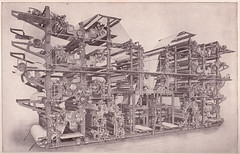When you make things for digital distribution, think of those things as assets. Think of the things you make as having a life that exists long after the publish button has been clicked. If you think like this, the things you make will be better.

In order to communicate a message–whether it’s marketing or civil preparedness or religion or any other kind of message we share–we need to do a few things:
- Have a message
- Wrap the message in a format and call it “content.”
- Distribute the content
Often a great deal of focus is given to the end of this chain of events and not enough to the earlier items. Thinking like this–focusing on the distribution primarily–can lead to bad decisions.
When our focus is on the distribution we are more likely to pursue short-term metrics like pageviews and clicks and likes and shares and retweets. Worse still, we’re likely to pursue them for only a short period of time: 24 hours after distribution, 48 hours after distribution, maybe a week at most. We make bad decisions about content when we value it only as much as Wednesday’s newspaper.

Unless our message is only valid for 24 hours, 48 hours or a week then we should have more concern for it. We should treat it more like an asset and less like Wednesday’s newspaper. We might give our message and content enough attention to help us all year instead of just a few days.
The not-very-subtle warning
Marshall McLuhan is famous for saying “The medium is the message.” This quote is often used in all sorts of interesting contexts that usually are very focused on the method of distribution (which, in old media days was more tightly bound to specific content formats).
But if you aren’t in the content distribution business McLuhan’s phrase should be heard as a warning: if you haven’t given proper care to your message then your message won’t be heard–only the distribution method will be heard:
You had a Super Bowl ad. No one remembers what it was about or even the brand in the ad. Someone won an award for that ad carrying a message that no one remembers two weeks later.
We see this today among a wide variety of ineffective social media and web publishing efforts. When I say ineffective I mean in a business sense: efforts which are burning cash at a higher rate than they are generating cash. Decision-makers running these efforts get on stage and talk about short-sighted metrics such as likes, retweets and traffic spikes. As other examples they might cite companies which have no real revenue stream beyond venture capital or companies which generate revenue on an entirely different model such as impression-based advertising.

Ineffective social media and web publishing efforts consume a great deal of resources on the part of their practitioners. The focus can quickly be identified as short-term. There is no care or treatment of the message or content that would signify any value lasting beyond 48 hours.
The content is throwaway. The message is throwaway. How will a brand be built on throwaway? How will a sale be made on throwaway? How will someone make an important decision based on throwaway?
It isn’t social media or web publishing that is ineffective. It isn’t the distribution method that’s ineffective. What is ineffective is decision-making that abdicates message and good content to pursue throwaway.
Making decisions
If you are a decision-maker who deals with communicating a message to other people then you have some choices.
- You can assess the lasting value of your message.
- You can decide to encapsulate your message in a specific format.
- You can decide to distribute that content in relevant ways.
You can decide whether a specific message is only true and useful for the next few days or whether it is true and useful for much longer than the next few days.
Then, as a decision-maker, you can choose to treat your content like an asset.
Caveats
There are, of course, exceptions and times when it is the right decision to treat a message and the resulting content like Wednesday’s newspaper. Sometimes a message really is short term. Sometimes a specific business really is short term. And some business models, like impression-based advertising, are able to operate well using short term evaluation of metrics.

It is important, however, to have a valid assessment of your own business and message value without defaulting to treating content like Wednesday’s newspaper.
Some more reading for decision makers who deal with message and content
What Ate the Periodical? by David Sleight at A List Apart examines the newspaper and magazine businesses from an historical and business perspective to develop insights for contemporary digital content distributors.
Volkswagen’s vibrating Rowdy Rathore in which Karthik S examines some advertising content developed by Volkswagen for distribution in India.
The Age of Excellence in which Jason Calcanis argues that there is no room for being good in the marketplace.

“The content is throwaway. The message is throwaway. How will a brand be built on throwaway? How will a sale be made on throwaway? How will someone make an important decision based on throwaway?”
Another way to look at is is to say that the content has become a commodity and the message is a commodity. Even if the good or service being sold is not itself a commodity, the process of promoting it ends up commodified…which means there are, by definition, many substitutes, many alternatives for the would-be message recipients to consume.
To belabor the commodity metaphor a bit, how does a commodity business (think “supermarket”) make money with slim margins? Volume. In the same way, a commodified communications strategy necessarily has to jack up the frequency of messaging…which itself cheapens each message’s perceived value.
So yes, treat your content like a valuable asset, and maybe manufacture a little scarcity in the name of growing your content’s value.
Bravo bravo bravo! You nailed it iug time! In my business of real estate , the message is…well there never is a message, and luckily people buy in spite of it. Just imagine the possibilities if there was an awesome message about every home, or office space. Great post! Thx